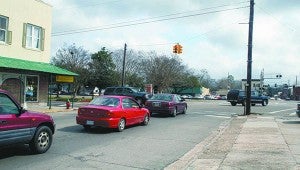Study at Canal, Main surprises public works director
Published 7:01 am Wednesday, February 19, 2014

SIGNAL STAYING: Cars are lined up down West Canal waiting for the light to change. The city recently completed a traffic count at this intersection to help it determine any changes that may need to be made in the traffic signal’s timing.
Photo by Will Sullivan
The Picayune Public Works Dept. has made the “big” decision concerning the traffic signal at the corner of West Canal and Main Street.
“The big news was will the light go away or will it stay. … It will stay,” said Eric Morris, the department’s director.
He said the city did its traffic count after reviewing Mississippi Department of Transportation estimates of the amount of traffic that passes through that intersection daily. MDOT’s estimate was an average of 6,400 vehicles pass through the intersection every day.
“We looked at it and said ‘No way can there be that many cars going through there,’ and decided to do a traffic count,” he said.
Morris acknowledged his surprise when the count came back showing an average of 6,340 to 6,360 vehicles did in fact pass through the intersection daily. Morris said his department gathered the data from the counters the city had installed in all four directions at the intersection, “7:30 (a.m.), noonish, 3:30 (p.m.) and 5:15 (p.m.).”
“They (MDOT) got it right,” he said.
The big question now is how the timing of the signal may change, the public works director said.
“We’re still analyzing the data,” said Vernon Moore of Dungan Engineering, the firm used by the city for most engineering work.
He and Morris said there is another consultant, a specialist in traffic signals, to whom they plan to send the data for his analysis and suggestions. Morris said the consultant understands the software part of traffic signals that has come into use in recent years. He said the signals used to be timed off of clocks, or changes triggered by mechanical devices.
Morris said the timing could be changed simply by setting the signal to turn green or red after so many minutes for one street and so many for the other. Or “loops” could be installed in the road surface to trigger a change, he said.
The two men hope to get the data to the consultant in the next day or two and have their answers by the end of next week.




